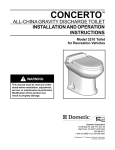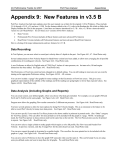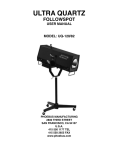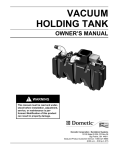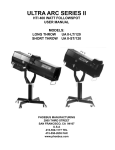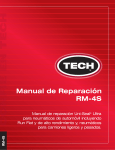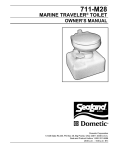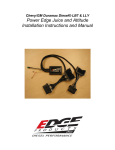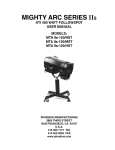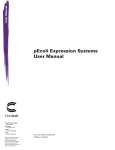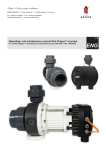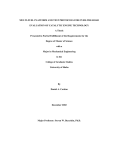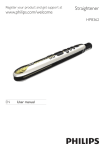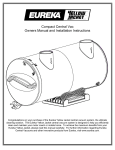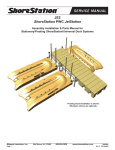Download Performance Trends` “EZ Flow”
Transcript
1 Performance Trends’ “EZ Flow” EZ Flow is a kit which allows engine builders build a computerized flow bench from materials available at most any hardware store. First you must build a bench following the parts list, plans and suggestions below. Parts List Qty Part Number Source/Description 1 PFAEZBA 1 PFAEZO-x.xx 3 PFAEZTB.125 3 2 PFAEZPP.125 PFAEZFL4 1 1 PFAEZMPT PFAEZ90-4 2 2 2 1 1 PFAEZPVC4-19 PFAEZPVC4-10 PFAEZFT PFAEZRDx.x PFAEZOx.xx 1 PFAEZFS-4 1 1 1 OFPB OBA OFCV Std Bore Adapter, part of Performance Trends EZ Flow System with SB Chevy and SB Ford bolt patterns and approx 4.03” ID (other bolt patterns available) Flow Orifice (x.xx is diameter), part of Performance Trends EZ Flow System Available sizes are 2.5” (400 CFM), 2” (250 CFM), 1.5” (150 CFM), 1.0” (75 CFM) 24” lengths of 1/8” clear PVC tubing for routing pressure to sensors in Black Box, part of Performance Trends EZ Flow System 1/8” NPT to 1/8” barbed hose fitting (Ace Hdwe 4013108) 4” PVC flanges w 6” bolt circle holes (NIBCO 4851 Genova 75141) Note that these may have to be drilled to match the bolt pattern of the PFAEZO-x.xx orifice, and have the face sanded or ground smooth to provide an air tight seal using the PFAEZFT. 4” PVC to male pipe thread adapter (NIBCO 4084, Genova 70440) 4” PVC 90 deg streamlined elbow (NIBCO 4807, Genova 72840, Genova 73840 for a more gradual bend) 19” length of 4” schedule 40 PVC straight tubing 10” length of 4” schedule 40 PVC straight tubing 24” lengths of light foam tape/weather stripping Rubber reducers, 4” to x.x inch (available sizes, 4”, 3”, 2.5” and 2”) 6” square calibration orifice plate with x.xx inch diameter sharp edged orifice (available sizes are 3.0, 2.5, 1.875, 1.5 and 1.0 inches) 4” grid flow straightener (2’x4’cut from white egg crate Home Depot ceiling “lighting panel” 74507 43200) Optional Flow Plenum Box Optional Fabricated bore adapter, for heads other than SB Ford or SB Chevy Optional Flow Control Valve, to help maintain a constant test pressure For “High Flow” 6” PVC EZ Flow Systems 1 PFAEZBA6 2 PFAEZFL6 1 PFAEZMPT6 1 PFAEZ90-6 6” Bore Adapter, part of Performance Trends EZ Flow System with SuperFlow ™ flow bench bolt pattern for your bore adapter. 6” PVC flanges w 9.5” bolt circle holes (McMaster Carr 4881K221). Note, use the PFAEZFT to provide an air tight seal. Visit www.mcmaster.com to order. 6” PVC to male pipe thread adapter (McMaster Carr 4880K161). Visit www.mcmaster.com to order. 6” PVC 90 deg elbow (Lowes Charlotte Pipe 6" PVC 90° Elbow Item #: 53037 Model #: PVC 00300 1600). Visit www.lowes.com to order. Notes for assembly: The diagrams given here are just a couple of assembly layouts. Due to space constraints, your shop layout, etc, you may decide to do things differently. Here are some tips to keep in mind for all systems. Leaks are a major contributor to flow bench inaccuracies and non-repeatable readings. Take precautions to eliminate all leaks. If you construct portions of your flow system out of wood, be sure to laminate or paint with several coats to eliminate the porosity of the wood. Generally, the more the volume between the head (or test piece) and the flow orifice the better, it it doesn’t introduce leaks. The system shown on the next page with the plenum shows this extra volume, so the air can “stabilize” between the head and the flow orifice. If you use a plenum, be sure that the air stream from either the head or the flow orifice are well separated, so the flow velocity from one does not influence flow on the other. 2 You must measure the Test Pressure from a relatively “quiet” area, away from flow velocity. If you use a plenum, tap into a remote corner of the plenum. If you use just the 90 deg elbow, Tee into the flow orifice pressure tap on the side nearest the head (test piece) . Pressure taps to record pressure across Flow Orifice should be as close to orifice as practical, to be in the “dead flow” area in corners. See Detail to right. For best accuracy/repeatability, keep the amount of straight PVC tubing before and after the flow orifice to 15” minimum (30” total). If space allows, longer is better. For ease of assembly, it is recommended that the joint between PFAEZPVC4-10 and PFAEZ90-4 be easily assembled and disassembled. You may want to seal this with heavy grease or tape, and attach the 2 pieces with screws or bolts instead of PVC cement or some other type of sealant. NOTE: Orifice plates must be no larger than half the inside diameter of the PVC tubing it is mounted in. For example, a 2” orifice is the maximum size for a 4” PVC tube. To Head If needed, you can Tee into this pressure tap for the test pressure sensor. Orifice Plate in tube Pressure taps should be as close to orifice plate as possible, to avoid taps being exposed to air velocity. 3 EZ Flow System Build Diagram Bench top with 5.2-5.5” hole cut for bore adapter PFAEZBA bolted to bench top via mounting holes PFAEZMPT PFAEZO-x.xx (orifice) PFAEZPVC4-10 *** PFAEZPP.125 * ** To Vacuum/ Pressure Source PFAEZPP.125 * PFAEZ90-4 Recommend this joint be temporary. See Notes. PFAEZFL4 PFAEZFS-4 Flow Straightener PFAEZPVC4 PFAEZFL4 PFAEZRDx.x (reducer) PFAEZPVC4 PFAEZFS-4 Flow Straightener * Keep the PFAEZPP.125 as close as practical to the orifice plate, to ensure the pressure seen is out of the air flow ** You can use this pressure as both a flow pressure and as the test pressure for the Black Box via a Tee fitting *** The length from the top of the PFAEZBA to the PFAEZ90-4 (90 deg elbow) should be 10” min., longer is better OBA Optional Bore Adapter fabricated to adapt to user’s cylinder head or test piece Suggestions for controlling the test pressure, either with a restrictor valve or a bleed valve. Tap into a remote corner of the plenum for Test Pressure 5 pipe diameters minimum. See NOTE below. Optional OFCV Keep air flows from bore adapter and flow orifice well separated so flow velocities have time to “settle out” and not influence OFPB Optional Plenum Box the flow or pressure the other air flow. The OFCV valve will restrict flow. NOTE: If you want to control test pressure with either a restrictor You can also use a “bleed” valve to valve (like the OFCV), or with a “bleed” valve, these should be control pressure. This valve can placed 5 pipe diameter away from flow orifice (30” for 6” pipe). typically be smaller than the pipe size, You can also reduce pipe size at this point for easier building. say, 2-3” valve for 6” main pipe. 4 Notes on Mounting PFAEZBA Bore Adapter Piece mounted on top, like a bore adapter for different cylinder size, or a calibration orifice ¼ 20 Threaded mounting holes Be sure that the ¼ 20 screws do not touch when tightened, if top bolt is used Small Block Ford Bolt pattern Small Block Chevy bolt pattern Optional Mounting: Use 4 10x32 countersunk flathead screws in tapered holes. PFAEZBA Bench Top Tapered holes for 10x32 mounting screws Vacuum Source Tips For Intake Flow, connect vacuum hose to EZ Flow System and let pressure hose blow into room For Exhaust Flow, connect pressure hose to EZ Flow System and let vacuum hose suck from room Vacuum/Pressure Source Like a Shop Vac or a higher pressure & flow source fabricated by user ** PFAEZRDx.x (reducer) Rubber Adapter * PFAEZPVC4-19 from EZ Flow System * Home Depot ™ or Ace Hardware ™ have a wide array of rubber adapters in the plumbing department, one brand being PIPECONX by UniSeal ™ ** Grainger and McMaster Carr have both vacuum motors and large diameter vacuum hose where you can fabricate a high capacity vacuum/pressure source To produce more than 20” water test pressure, you will most likely need 2 stage vacuum motors. To produce more than 30” water test pressure, you will most likely need 3 stage vacuum motors. To build a high capacity flow bench, you need several vacuum motors, about 1 for each 70 CFM of flow you want at 28” water. This will require a lot of electrical power (amps), and most likely 220 VAC and a good, knowledgeable electrician. You must also reduce all flow restrictions to a minimum, so all the pressure/vacuum can be used to produce a pressure drop across the head (test piece). This also means the flow orifice must be sized quite large, so it does not become too restrictive. 5 Vacuum Source, Custom Build “Shop Vacuum” If you want more flow capability than a large Shop Vacuum, you can build one following the basic outline below. Contact us for typical part numbers for good vacuum motors. Each motor requires about 10 amps 110 VAC and provides 50 to 80 CFM at 28”, depending on EZ Flow details. ¾” plywood box top view vacuum motor wood or metal ring with hold down bolts to hold motor in place hole in ¾” plywood divider end view side view Note: Use LOTS of screws to hold plywood box together as the pressures inside over a large area create LOTS of force. High Pressure Side Low Pressure Side (suction) Routing of air: The easiest method is to attach 2 large hoses, one to the top high pressure side and one to the bottom low pressure side. Then you can route the air as shown in the previous Figure of the shop vacuum. A more permanent air routing/diverting method is outlined below. Steel “diverter” plate 4 holes in end of box Route these 2 holes permanently to EZ Flow System, with Y hose fitting or with a plywood chamber on the end of the box. These 2 holes can be open to room air. High pressure going to EZ Flow (exhaust flow) Low pressure (suction) to EZ Flow (intake flow) High Pressure Side Low Pressure Side Top 2 holes are on the High Pres. Side of box Bottom 2 holes are on the Low Pres. Side of box Tips: It is easiest to have 2 wooden end panels, each with 4 holes, with the diverter plate sandwiched between them. Space the 2 panels apart with washers for a tight clearance. Fasten together with bolts. Use one large bolt as the pivot for the diverter plate. You can get fancy with bearings or bushings if you want. Leaks here in this box do not affect accuracy, just the efficiency of how much total CFM you can generate. 6 Instructions for Black Box Hookup to Flow Bench Once you’ve built your EZ Flow flow bench, you will connect the Black Box. Performance Trends’ “Black Box” data logger will record data from your EZ Flow flow bench to greatly enhance your flow bench testing. The 2 figures below give an explanation of the various connections to the Black Box. DB9 w male pins connector to communicate to computer. You MUST use cable provided by Performance Trends. Power Jack (12 volt DC, 300 mAmp) DB9 w female sockets connector for Swirl Meter input. Frequency Inputs (typically not used and are not included on later Black Boxes) Enable Foot Switch To enable the use of a foot or hand switch for recording data with the Black Box, you must enable the switch. Do this by clicking on Options in the Electronics Reading screen, then clicking on BB2 Foot Switch, and select which temperature channel to use for the Foot or Hand Switch. Typically this will be “Use Flow Temp (T2) Channel” because “Test Temp” is used for recording temperature of the air flowing through the test piece. If you want to record temperature on the same channel as a switch is attached, you need a special “Tee” harness from Performance Trends. Power light indicator High Pressure side of Pitot Tube sensor High Pressure side of Inclined Manometer (flow pressure) High Pressure side of Vertical Manometer (test pressure) Test Temperature (temperature of air passing through head or test piece) Flow Temperature (temperature of air passing through flow orifices). Black Box II foot switch can go here or to Test Temp. See figure below. 7 Bore adapter Valve Opener and Lift Measurement Vacuum motors for flow source Flow Control Valve to set Test Pressure, may not be necessary for standard Flow Tube Flow Orifice Flow Tube with Orifice Aux Pres. or Pitot Tube Pres. Low Aux Pres. or Pitot Tube Pres. High Cylinder Head High pressure tap on pitot tube. Low pressure tap on pitot tube The pressure tap for test pressure (measuring pressure under the head) should be placed in a “dead” flow area, and not in a location where air is rushing by it. This produces a Bernoulli “suction” pressure which is not correct. You can also Tee into the pressure tap on the head side of the flow orifice pressure taps, as shown in picture on page 2. However, due to flow losses, flow straighteners, etc, this pressure is not exactly the same as the pressure directly under the head. 8 Software Setup With the Black Box connected, you will want to setup the software. Follow the process outlined in Examples 4.1 and 4.2 in the manual. When doing the Flow Bench Specs setup, follow the instructions outlined below. NOTE: There are demo movie files on our website which can help you get “up to speed” quickly. On our website, click on Support, then Movie Demo Files, then find the Port Flow Analyzer movies. First, open up the example test called “EZ Flow Example”. Click on File at upper left corner of main screen, then “Open (from all saved tests)”. Then in this Open Test File screen, choose (click on) “Examples” in the lower right corner for the folder, then choose (click on) “EZ Flow Example” in the upper left corner, then Open in the lower left corner. This will load several test and flow bench settings to get you up and running quickly. Open the “EZ Flow Example” File Choose the EZ Flow Example test file, then click on Open in the lower left corner. Click on File, then Open (from all saved tests) Choose Examples for the Folder 9 Confirm that these critical specs are correctly set in this EZ Flow Example test file, as shown below. EZ Flow System Setup in Port Flow Analyzer Software Click on Flow Bench at top of Main Screen to bring up Flow Bench specs screen shown here. Select EZ Flow System for the Flow Bench Type. Most specs in this screen are now disabled and are being set automatically by the software. Click on Find Com Port button to have the program look for your Black Box II. Even if you are using a USB adapter, it will still show up as a Com Port. Click on See Details button to bring up screen shown below. Enter both the Offset and Factor for Test Pres. sensors as shown here. These numbers (-133 and .055) are approximate, but work well for most situations. For OLDER boxes with ASCX sensors (plastic pressure taps extend above top of box), these numbers change to -80.5 and .038 respectively. For added accuracy, you can also click on this Calibrate button and follow the program instructions to calibrate the sensor to a water manometer. See Figure on next page. 10 Calibrating the Test Pressure Sensor with a Water Manometer Tee in a water manometer to the test pressure line to calibrate the test pressure sensor in the Black Box A water manometer can be as simple as a loop of clear plastic hose with colored water filling a little over half of the hose. It is much easier to work with a “tall” manometer, where the total height of the loop is 40 inches or more. The pressure you record is the total difference in height of the water levels. See Appendix 2 in the Port Flow Analyzer’s user manual. Once the Test Pressure (vertical manometer) sensor has been calibrated, or had estimated readings entered, you can calibrate the entire EZ Flow Flow Bench following the procedure outlined in the figures on the next page. 11 Calibrating the EZ Flow System Click on Calibrate, then select either Intake or Exhaust for the flow direction to calibrate. Enter the diameter of the orifice you have installed on the EZ Flow system as pictured below. Click on Measure Flow Data and follow the program instructions. You will first let the program record zero pressures (with no flow, bench off). Then you will turn on the bench and record pressures for this known orifice size. The results will be shown at the top as “New Full Range CFM”. Click on the Use Calc Value to keep this new calibration. IMPORTANT: You can estimate the New Full Range CFM you should get from this calibration by squaring the diameter of the flow orifice in the tube and then multiplying by 50. For example, for a 2.5” orifice, it should be approximately 2.5x2.5x50 = 312.5 CFM. If your calibration does not come close to this (within 10%), double check what you are doing. Make (or purchase from Performance Trends) an orifice plate to bolt to the Bore Adapter where the head (test piece) would normally bolt. Seal for leaks. 12 Depending on various combinations of settings, it may be necessary to set the Preference under the “Gen. Operation, cont.” tab of “Black Box Reads +/- Pres.” to “Yes (NO checking)”. See Figure below. Preference Settings Click on Preferences Then set Black Box Reads +/- Pres. to “Yes (NO checking)” EZ Flow w Black Box.doc 13 6" EZ Flow System's Bore Adapter and Assembly 14














